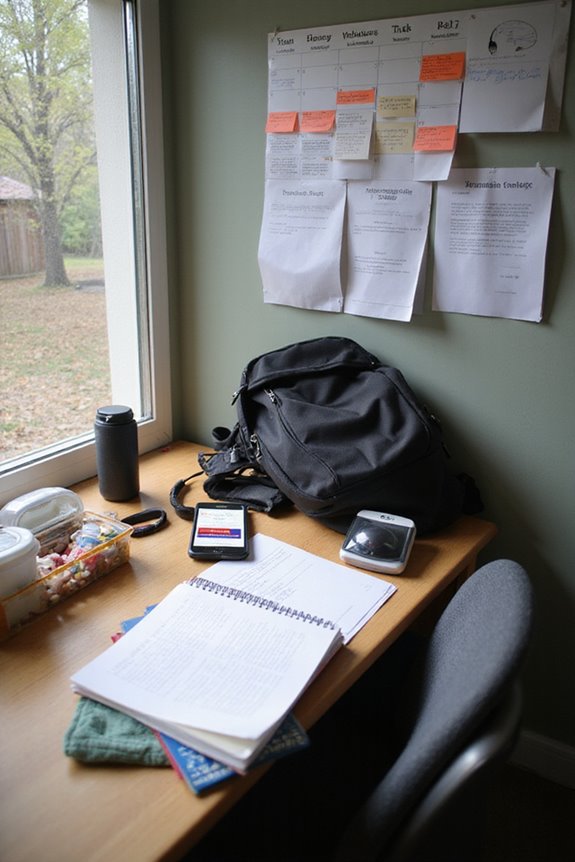Chronic pain adversely affects academic performance through several mechanisms. Psychological impacts include increased anxiety and emotional turmoil, leading to poor focus. Attendance issues are significant; 64.2% of students with chronic pain experience chronic absenteeism. Gender differences show that female students report higher pain intensity, resulting in lower concentration and academic performance. Additionally, socioeconomic factors and parental education play critical roles in shaping educational outcomes. Understanding these complexities is essential for supporting affected students. More insights await.
Key Takeaways
- Chronic pain leads to emotional turmoil, increasing anxiety and frustration, which negatively impacts focus on academic tasks.
- Students with chronic pain experience significant absenteeism, resulting in gaps in knowledge and declining academic performance.
- Emotional distress from chronic pain can impair cognitive functions like attention and memory, affecting learning capabilities.
- Female students report higher levels of chronic pain, leading to increased absenteeism and greater academic decline compared to male counterparts.
- Supportive parenting and higher parental education levels can mitigate some academic challenges faced by students with chronic pain.
Psychological and Social Impacts on Learning
How does chronic pain influence academic performance through psychological and social channels? Chronic pain can notably disrupt both psychological well-being and social interactions, which are vital for effective learning.
- Emotional Dysregulation: Individuals with chronic pain often struggle with emotional regulation, leading to increased anxiety and frustration. This emotional turmoil can hinder their ability to focus on academic tasks.
- Social Withdrawal: The psychological burden of chronic pain frequently results in social withdrawal. This isolation limits peer interactions, which are essential for collaborative learning and support.
- Impact on Motivation: Reduced engagement in social settings can exacerbate feelings of loneliness, affecting motivation and academic persistence.
These factors collectively illustrate the complex interplay between chronic pain and academic performance, highlighting the need for supportive interventions.
Attendance Issues and Declining Academic Performance

Chronic pain considerably impacts attendance rates among students, thereby influencing their academic performance.
- Chronic absenteeism among students with chronic pain is significant, with 64.2% reporting school absenteeism over a year.
- The rate of chronic absenteeism in U.S. schools was approximately 31% in 2021-2022, decreasing to 28% in 2022-2023.
- Health conditions, particularly chronic pain, correlate with higher absenteeism rates (28.7% for students in fair or poor health).
- Schools with over 20% chronic absenteeism face challenges in maintaining teaching standards, negatively affecting all students.
- Frequent absenteeism leads to gaps in knowledge acquisition, compounding academic consequences over time.
The Intersection of Chronic Pain and Learning Disabilities

The intersection of chronic pain and learning disabilities presents significant challenges for affected individuals, as these conditions often coexist and exacerbate one another.
- Chronic pain prevalence among individuals with intellectual disabilities is estimated at 13%, influenced by factors such as physical comorbidities and reduced health decision-making involvement.
- Emotional distress from chronic pain can impair cognitive functions, including attention and memory, vital for academic success.
- Communication barriers further complicate pain assessment, as many individuals struggle to articulate their experiences, leading to underdiagnosis and inadequate pain management.
- Effective communication strategies and awareness training for educators and healthcare providers are essential for recognizing pain signals, facilitating timely interventions.
- Addressing these complexities is essential to support academic performance and overall well-being in this population.
Gender Differences in Pain and Academic Outcomes

Gender differences greatly influence the experience of chronic pain and its subsequent impact on academic outcomes. Research indicates that:
- Women experience chronic pain more frequently and report higher intensity levels than men.
- Chronic pain in female students is associated with increased absenteeism and diminished concentration, negatively affecting academic performance more substantially than in males.
- Men often underreport pain, focusing on sensory descriptions rather than emotional aspects, which may lead to less academic support.
- Socioeconomic factors further exacerbate these gender disparities, with women facing higher risks related to educational opportunities and chronic pain severity.
Understanding these differences is essential for developing effective academic support strategies that address the unique challenges faced by each gender in managing chronic pain.
The Role of Parental Education in Academic Success

Parental education greatly influences academic success, as it establishes the educational foundation and support framework for children.
- Higher parental education correlates with improved school achievement, affecting child intelligence and mediating approximately 40% of the impact on academic success.
- Constructive parenting practices, stemming from better education, foster a supportive educational environment, influencing student motivation and resilience.
- Active parental involvement, characterized by setting high expectations and maintaining engagement, drives better attendance, behavior, and grades.
- Families with educated parents provide emotional and psychological support, leading to higher graduation rates.
- This influence transcends socioeconomic contexts, emphasizing the critical role of parental expectations in shaping children’s academic goals and achievements, ultimately enhancing their performance in school.
Frequently Asked Questions
What Are Some Coping Strategies for Students With Chronic Pain?
Students with chronic pain often utilize mindfulness techniques and engage in peer support to alleviate emotional distress. These strategies foster a sense of belonging, enhancing their ability to cope and navigate academic challenges effectively.
How Can Teachers Support Students Experiencing Chronic Pain?
Teachers can transform the classroom environment through specialized training, nurturing a supportive atmosphere. By implementing flexible schedules, open communication, and emotional support, they create a haven where students with chronic pain feel understood, valued, and engaged.
Are There Specific Accommodations for Chronic Pain in School Settings?
Specific accommodations for chronic pain in school settings include pain management strategies and classroom modifications. These may involve extended deadlines, quiet spaces, and assistance with physical tasks, fostering an inclusive environment for affected students.
What Role Does Physical Activity Play in Managing Chronic Pain?
Physical activity plays an essential role in pain management, offering exercise benefits that include reduced pain intensity and improved physical function. Tailored exercise programs foster adherence and enjoyment, enhancing overall well-being for individuals experiencing chronic pain.
How Can Parents Advocate for Their Child’S Educational Needs Related to Pain?
Parents can navigate the educational landscape like skilled navigators through stormy seas, using effective communication and educational resources. Their advocacy fosters understanding, ensuring that their child’s unique needs are recognized and supported within the academic environment.





